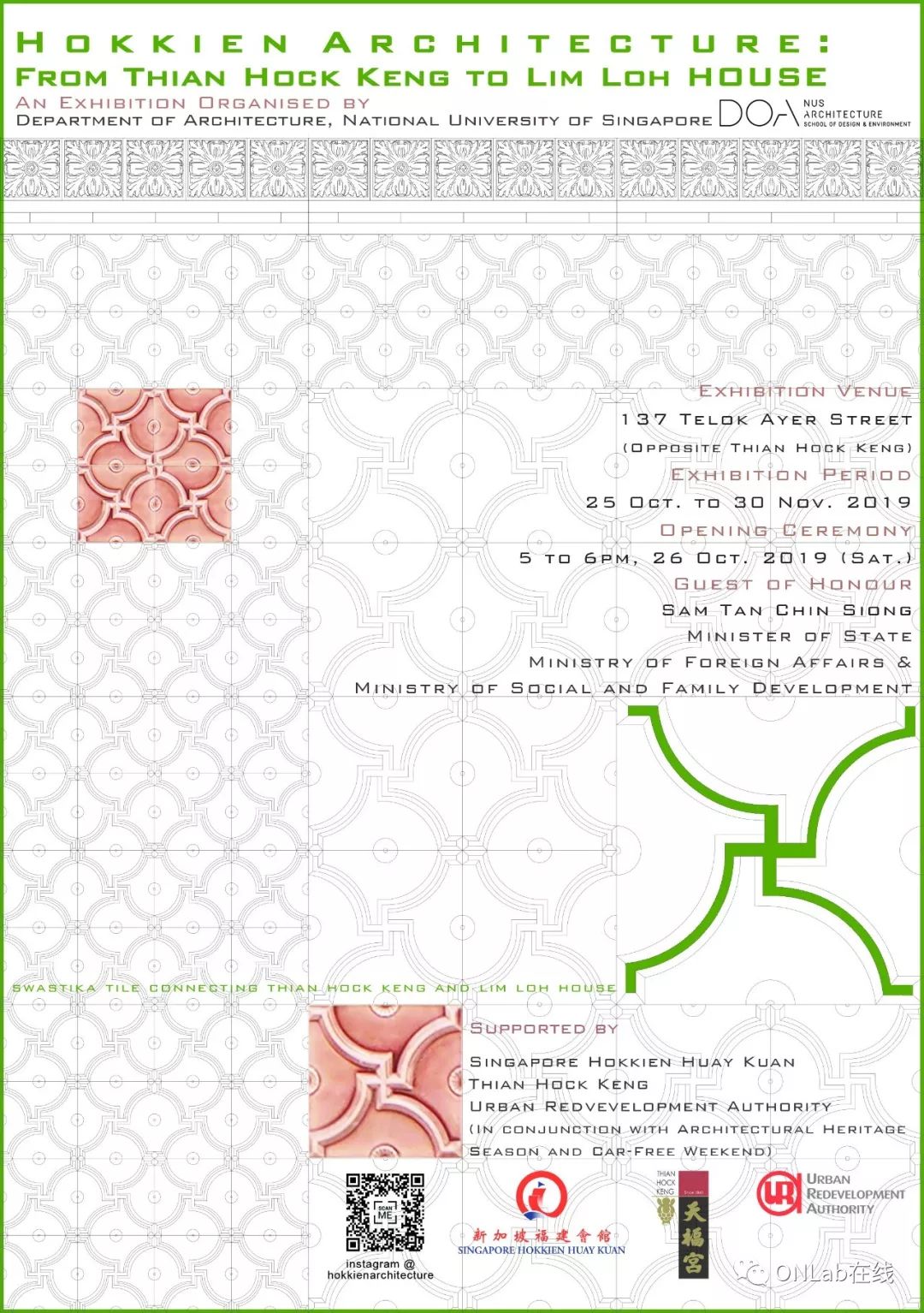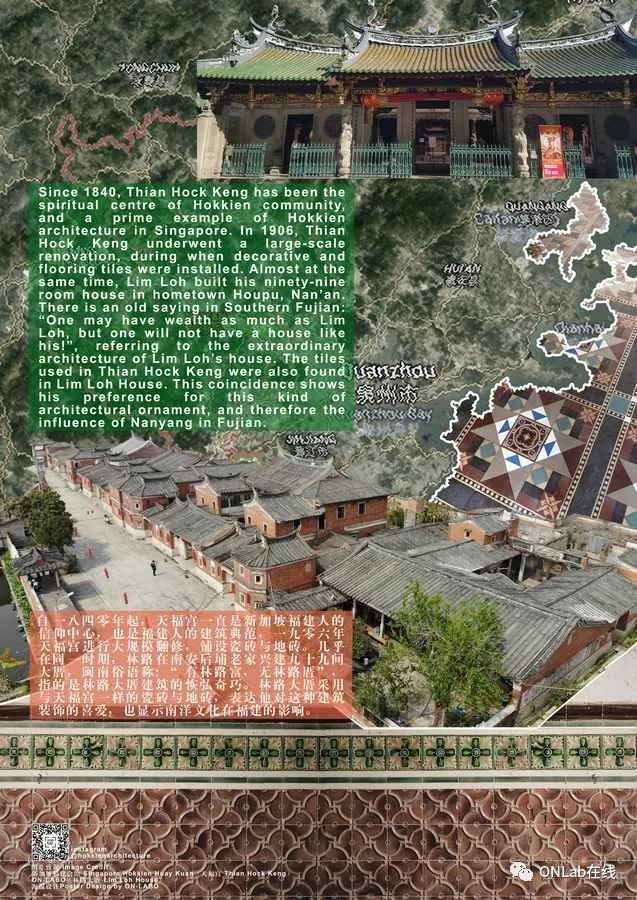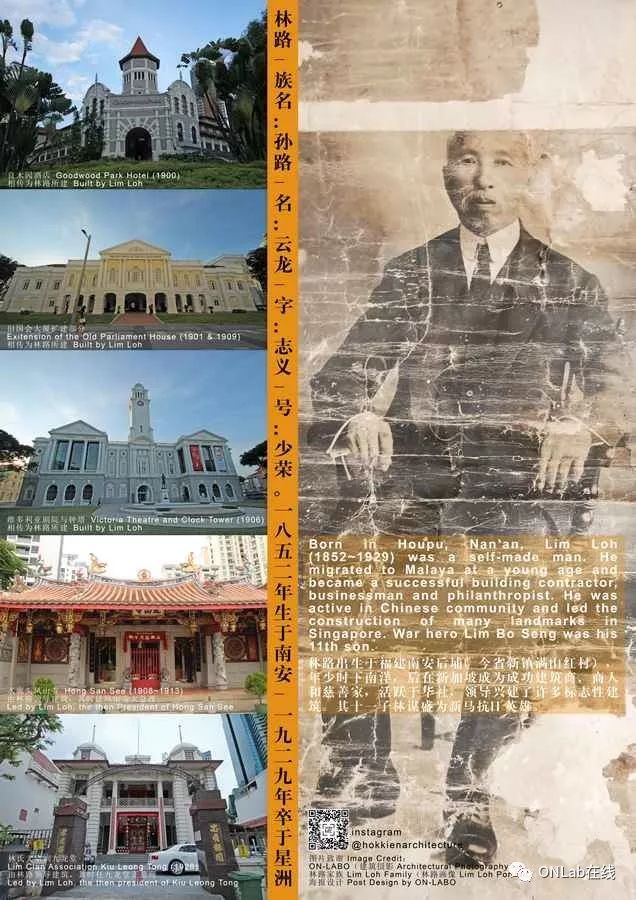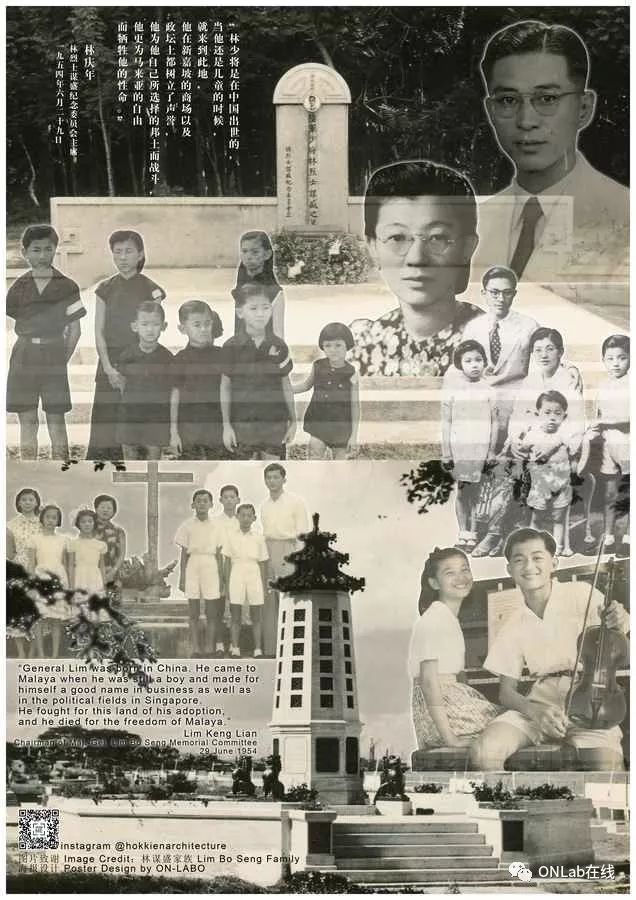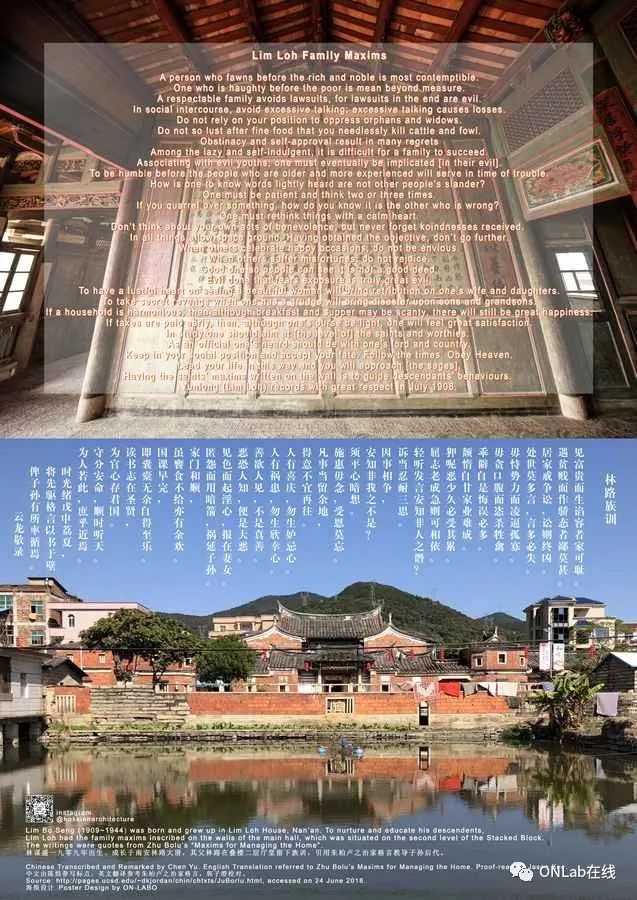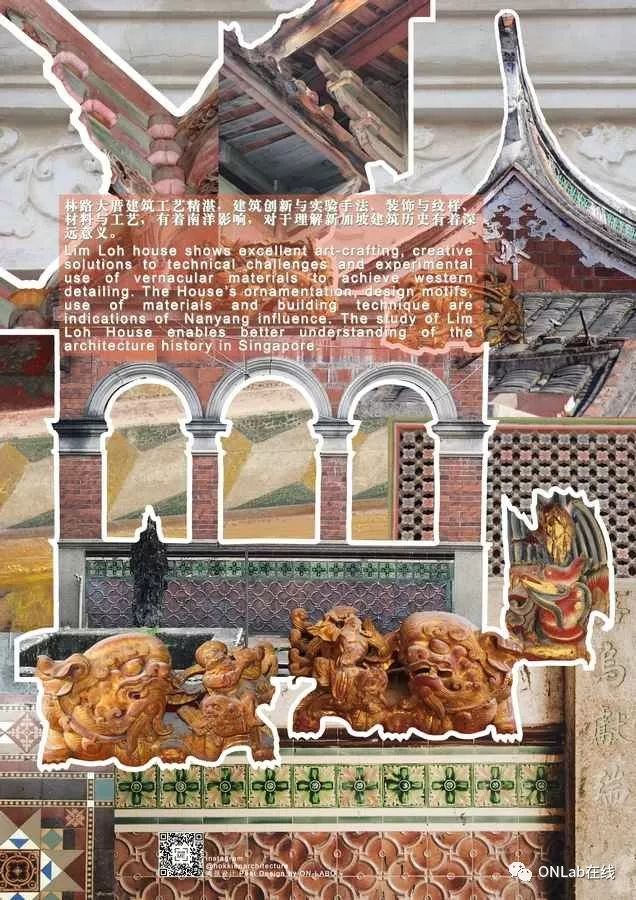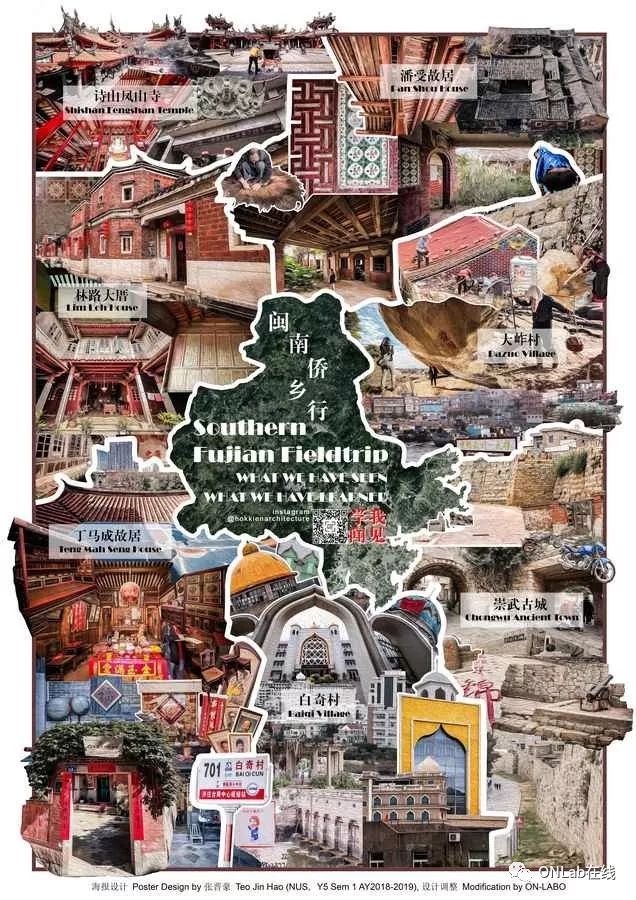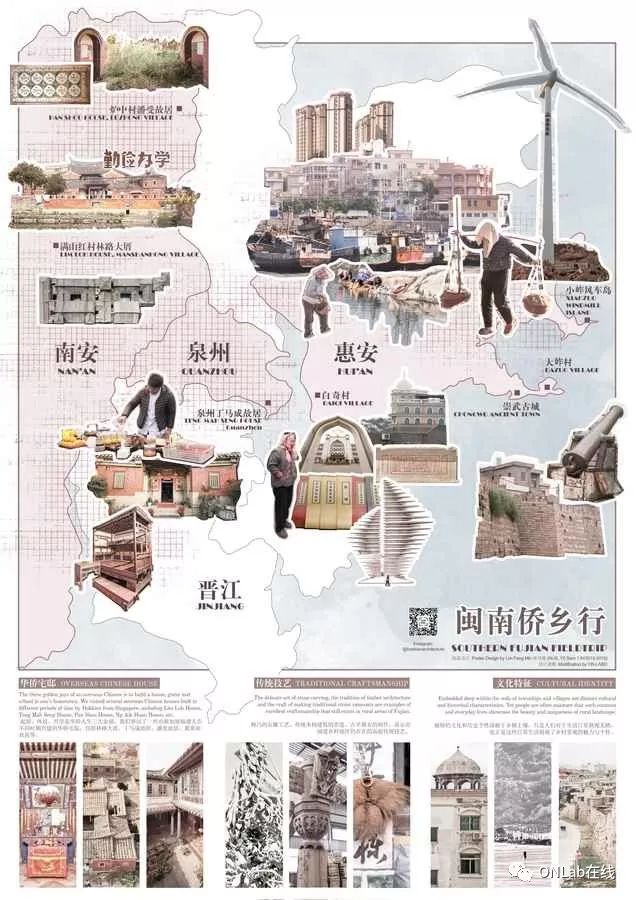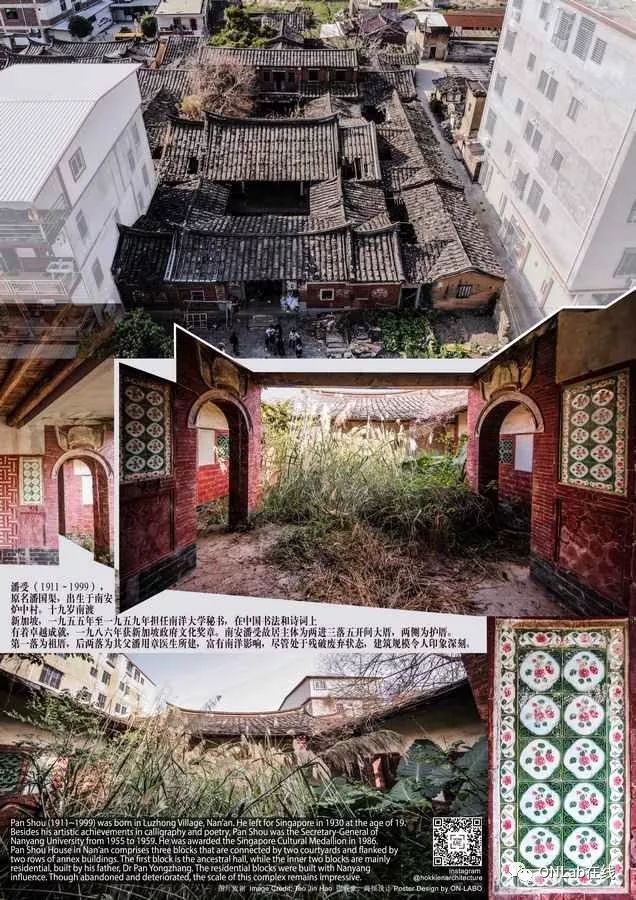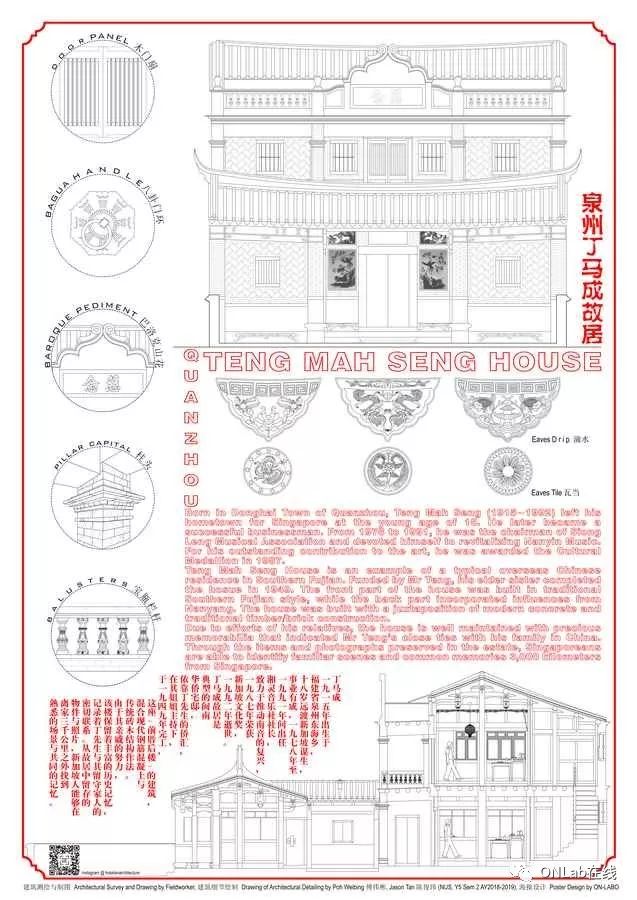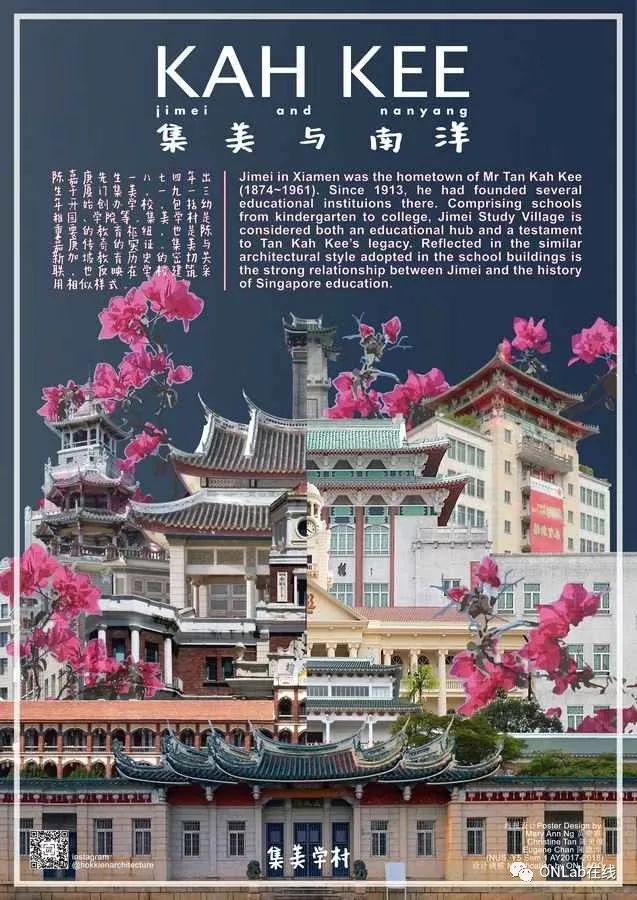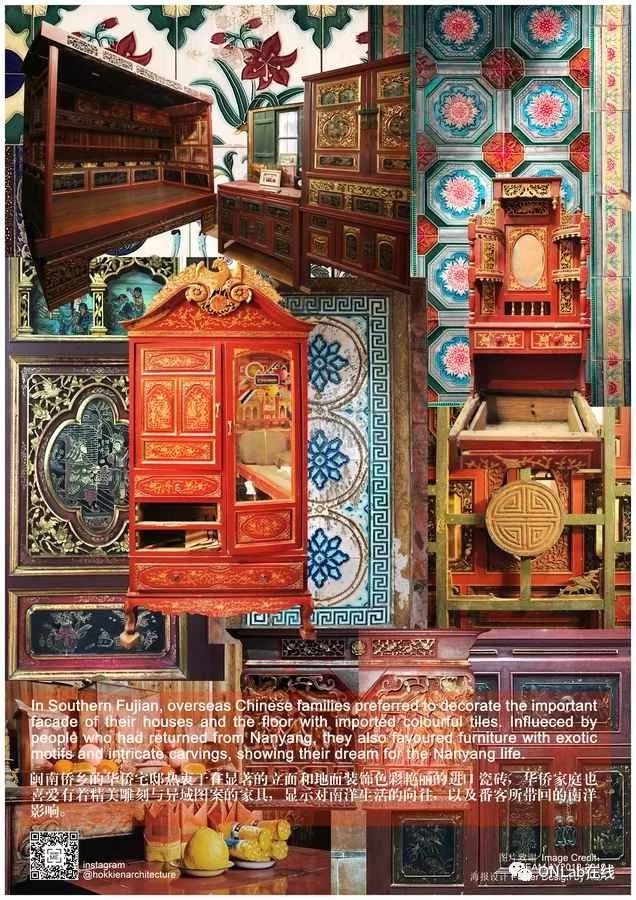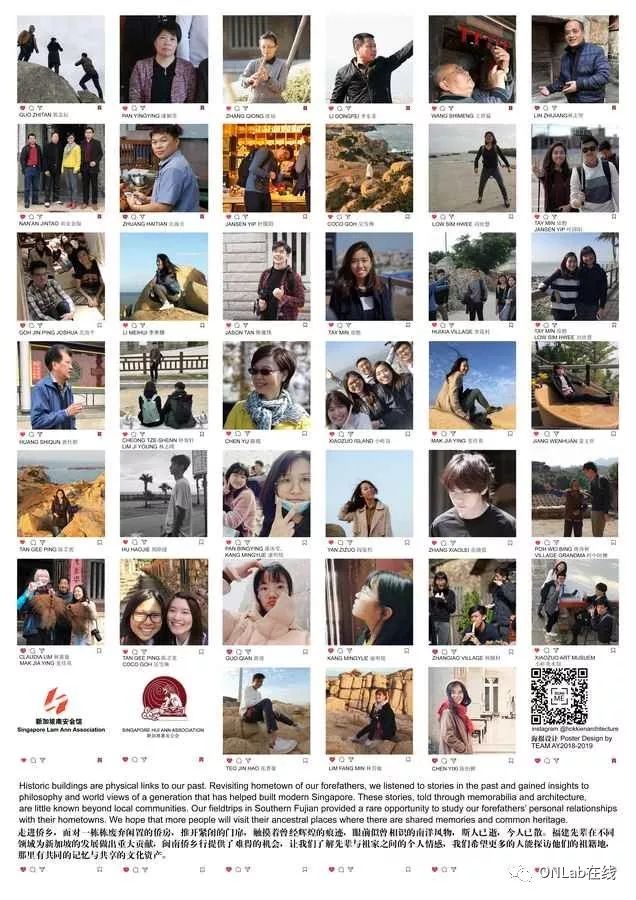ONLab在線 No.91
Exhibition Information
展覽信息
when and how to visit the exhibition? click the below image
點擊以下圖片獲取觀展詳情
Forewords
前言
本次展覽呈現二零一八至二零一九學年新加坡國立大學建築系學生的閩南僑鄉行所學。憑借面對天福宮的場地優勢,突出這座在新加坡地位崇高的福建人廟宇,與頭家林路(林謀盛少將的父親)在南安祖籍地修建的宗祠之間的關聯,展示新加坡華族建築的影響,揭示先民將南洋式樣與審美趣味帶回福建。同時紀念林謀盛少將犧牲七十五周年,展現他鮮爲人知的家庭生活,爲自由與正義做出的犧牲。This exhibition features learning from the Southern Fujian fieldtrips made in AY2018-2019 by students from the Department of Architecture, National University of Singapore. Taking advantage of the immediate visual association with Thian Hock Keng, this site-specific exhibition highlights the connection between this predominant Hokkien temple in Singapore and the ancestral houses in Nan’an built by Towkay Lim Loh (Major-General Lim Bo Seng’s father).It features Chinese architectural influences in Singapore, as well as how the unique style and sense of aesthetics of Nanyang (South Seas) had been brought by the early settlers to their hometowns in Fujian. To commemorate Major-General Lim Bo Seng’s 75th death anniversary, this exhibition provides vignettes to his little known family life and attempt to piece together a richer picture of one of Singaporean’s well-known martyr.
What is the link between Thian Hock Keng and Lim Loh House?天福宮與林路大厝有什麽關聯?自一八四零年起,天福宮一直是新加坡福建人的信仰中心,也是福建人的建築典範,一九零六年天福宮進行大規模翻修,鋪設瓷磚與地磚。幾乎在同一時期,林路在南安後埔老家興建九十九間大厝,閩南俗語稱:“有林路富,無林路厝”,指的是林路大厝建築的恢弘奇巧。林路大厝采用與天福宮一樣的瓷磚與地磚,表達他對這種建築裝飾的喜愛,也顯示南洋文化在福建的影響。Since 1840, Thian Hock Keng has been the spiritual centre of Hokkien community, and a prime example of Hokkien architecture in Singapore. In 1906, Thian Hock Keng underwent a large-scale renovation, during when decorative and flooring tiles were installed. Almost at the same time, Lim Loh built his ninety-nine room house in hometown Houpu, Nan’an. There is an old saying in Southern Fujian: “One may have wealth as much as Lim Loh, but one will not have a house like his!”, referring to the extraordinary architecture of Lim Loh’s house. The tiles used in Thian Hock Keng were also found in Lim Loh House. This coincidence shows his preference for this kind of architectural ornament, and therefore the influence of Nanyang in Fujian.
Who is Lim Loh?誰是林路?林路出生于福建南安後埔(今省新鎮滿山紅村),年少時下南洋,後在新加坡成爲成功建築商、商人和慈善家,活躍于華社,領導興建了許多標志性建築。其十一子林謀盛爲新馬抗日英雄。
Born in Houpu, Nan’an, Lim Loh (1852~1929) was a self-made man. He migrated to Malaya at a young age and became a successful building contractor, businessman and philanthropist. He was active in Chinese community and led the construction of many landmarks in Singapore. War hero Lim Bo Seng was his 11th son.
War Hero Lim Bo Seng and His Sacrifice
抗日英雄林謀盛與他的犧牲
“林少將是在中國出世的,當他還是兒童的時候,就來到此地,他在新嘉坡的商場以及政壇上都樹立了聲譽,他爲他自己所選擇的邦土而戰鬥,他更爲馬來亞的自由而犧牲他的性命。”
林慶年林烈士謀盛紀念委員會主席一九五四年六月二十九日“General Lim was born in China. He came to Malaya when he was still a boy and made for himself a good name in business as well as in the political fields in Singapore. He fought for this land of his adoption, and he died for the freedom of Malaya.”Lim Keng LianChairman of Maj.-Gel. Lim Bo Seng Memorial Committee29 June 1954
Lim Bo Seng’s Birthplace and the Education He Received
林謀盛的出生地與他所接受的教育
林謀盛一九零九年出生、成長于南安林路大厝,其父林路在疊樓二層廳堂留下族訓,引用朱柏盧之治家格言教導子孫後代。Lim Bo Seng (1909~1944) was born and grew up in Lim Loh House, Nan’an. To nurture and educate his descendents, Lim Loh had the family maxims inscribed on the walls of the main hall, which was situated on the second level of the Stacked Block. The writings were quotes from Zhu Bolu’s “Maxims for Managing the Home”.
Significane of Lim Loh House林路大厝的意義林路大厝建築工藝精湛,建築創新與實驗手法、裝飾與紋樣、材料與工藝,有著南洋影響,對于理解新加坡建築曆史有著深遠意義。Lim Loh house shows excellent art-crafting, creative solutions to technical challenges and experimental use of vernacular materials to achieve western detailing. The House’s ornamentation, design motifs, use of materials and building technique are indications of Nanyang influence. The study of Lim Loh House enables better understanding of the architecture history in Singapore.
Southern Fujian Fieldtrip閩南僑鄉行走進僑鄉,面對一棟棟廢棄閑置的僑房,推開緊閉的門扉,觸摸著曾經輝煌的痕迹,眼前似曾相識的南洋風物,斯人已逝,今人已散。福建先輩在不同領域爲新加坡的發展做出重大貢獻,閩南僑鄉行提供了難得的機會,讓我們了解先輩與祖家之間的個人情感,我們希望更多的人能探訪他們的祖籍地,那裏有共同的記憶與共享的文化資産。
Historic buildings are physical links to our past. Revisiting hometown of our forefathers, we listened to stories in the past and gained insights to philosophy and world views of a generation that has helped built modern Singapore. These stories, told through memorabilia and architecture, are little known beyond local communities. Our fieldtrips in Southern Fujian provided a rare opportunity to study our forefathers’ personal relationships with their hometowns. We hope that more people will visit their ancestral places where there are shared memories and common heritage.
Three Key Aspects of the Field Study考察的三大要點華僑宅邸 OVERSEAS CHINESE HOUSE起屋、休墳、興學是華僑人生三大金福,我們參訪了一些由新加坡福建人在不同時期興建的華僑宅邸,包括林路大厝、丁馬成故居、潘受故居、黃奕歡故居等。The three golden joys of an overseas Chinese is to build a house, grave and school in one’s hometown. We visited several overseas Chinese houses built in different periods of time by Hokkien from Singapore, including Lim Loh House, Teng Mah Seng House, Pan Shou House, Ng Aik Huan House, etc.
傳統技藝 TRADITIONAL CRAFTSMANSHIP精巧的石雕工藝、傳統木構建築的營造、古早蓑衣的制作,顯示出福建鄉村地區仍存在的高超傳統技藝。 The delicate art of stone carving, the tradition of timber architecture and the craft of making traditional straw raincoats are examples of excellent craftsmanship that still exists in rural areas of Fujian.文化特征 CULTURAL IDENTITY獨特的文化和曆史個性深植于鄉鎮土壤,只是人們對于生活日常熟視無睹,也正是這些日常生活展現了鄉村景觀的魅力與個性。Embedded deep within the soils of townships and villages are distinct cultural and historical characteristics. Yet people are often unaware that such common and everyday lives showcase the beauty and uniqueness of rural landscape.
Pan Shou House潘受故居南安潘受故居主體爲兩進三落五開間大厝,兩側爲護厝。第一落爲祖厝,後兩落爲其父潘用章醫生所建,富有南洋影響,盡管處于殘破廢棄狀態,建築規模令人印象深刻。
Pan Shou House in Nan’an comprises three blocks that are connected by two courtyards and flanked by two rows of annex buildings. The first block is the ancestral hall, while the inner two blocks are mainly residential, built by his father, Dr Pan Yongzhang. The residential blocks were built with Nanyang influence. Though abandoned and deteriorated, the scale of this complex remains impressive.
丁馬成故居Teng Mah Seng House丁馬成故居是典型的閩南華僑宅邸,依靠丁先生的僑彙,在其姐姐主持下,于一九四九年完工,這座“前厝後樓”的建築,混合現代鋼筋混凝土與傳統磚木結構作法。Teng Mah Seng House is an example of a typical overseas Chinese residence in Southern Fujian. Funded by Mr Teng, his elder sister completed the hosue in 1949. The front part of the house was built in traditional Southern Fujian style, while the back part incorporated influences from Nanyang. The house was built with a juxtaposition of modern concrete and traditional timber/brick construction.
Ng Aik Huan House黃奕歡故居黃奕歡故居落成于一九七六年,爲一進五開間的傳統閩南建築,正中廳堂供奉祖先牌位,包括其父母,宅邸內有多幅由潘國渠 (潘受 )題寫的對聯匾額。黃潘兩人是摯友。
Completed in 1976, Ng Aik Huan House is typical Southern Fujian Style architecture with one courtyard and five bays. The ancestors’ tablets, including his parents’, were worshipped in the main hall. In the house, several couplets written by Pan Guoqu (Pan Shou) were inscribed onto the pillars and carved on plaques. Ng and Pan were good friends.
Jimei and Nanyang 集美與南洋陳嘉庚先生一八七四年出生于廈門集美,一九一三年開始創辦學校,包括幼稚園、學院等。集美學村是重要的教育樞紐,也是陳嘉庚傳奇的實證。集美與新加坡教育曆史的密切關聯,也反映在學校建築采用相似樣式。
Jimei in Xiamen was the hometown of Mr Tan Kah Kee (1874~1961). Since 1913, he had founded several educational instituions there. Comprising schools from kindergarten to college, Jimei Study Village is considered both an educational hub and a testament to Tan Kah Kee’s legacy. Reflected in the similar architectural style adopted in the school buildings is the strong relationship between Jimei and the history of Singapore education.
Walk! Baiqi 行走白奇位于惠安(今泉州台商投資區)的百崎鄉是福建省唯一的回族鄉,其主要人口姓郭,百崎郭也移民至新加坡。白奇是百崎鄉的一個村,體驗白奇村豐富自然資源、曆史建築、回族文化的最佳方式是步行。Located in Hui’an (currently Quanzhou-Taiwan Economic Zone), Baiqi is the only ethnic minority town of the Hui people in Fujian Province. The majority of its population has the surname of Guo. Hundreds of Baiqi Guo people migrated and settled in Singapore. Baiqi is one of the villages in Baiqi Town. The best way to experience Baiqi’s rich natural ecology, historical architecture and ethnic Hui culture is by foot.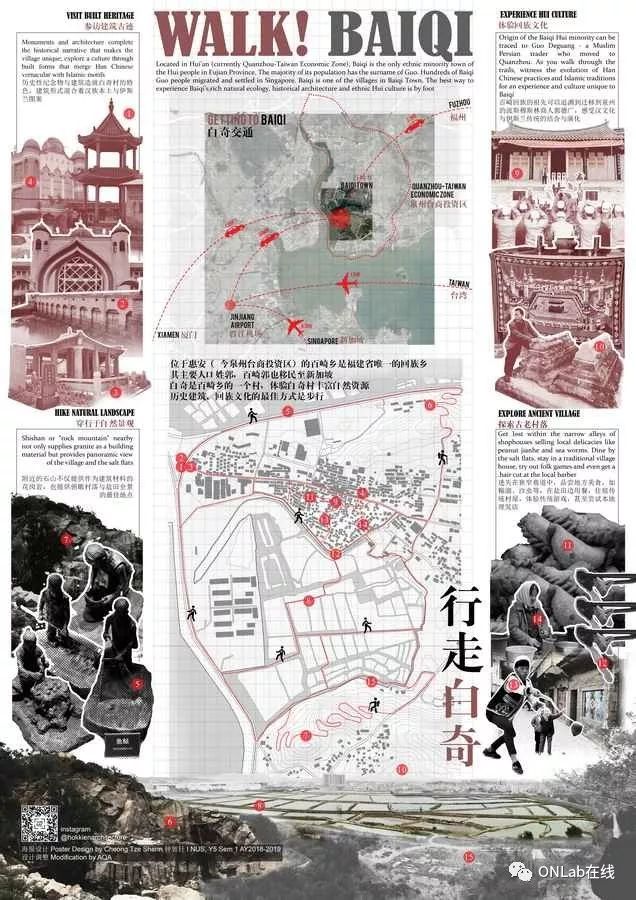
In Southern Fujian, overseas Chinese families preferred to decorate the important facade of their houses and the floor with imported colourful tiles. Influeced by people who had returned from Nanyang, they also favoured furniture with exotic motifs and intricate carvings, showing their dream for the Nanyang life.
致謝Acknowledgements:
新加坡南安會館(考察、出版)Singapore Lam Ann Association (Fieldtrip & Publication)新加坡惠安公會(考察)Singapore Hui Ann Association (Fieldtrip)張東孝先生(出版)Mr. Daniel Teo Tong How (Publication)新加坡福建會館(展覽)Singapore Hokkien Huay Kuan (Exhibition)天福宮(展覽)Thian Hock Keng (Exhibition)市區重建局(展覽)Urban Redevelopment Authority (Exhibition)
圖文均爲原創,歡迎轉發朋友圈;
如需轉載,請聯絡後台,謝謝!
長按二維碼訂閱
Press the QRcode to follow us
About ON-LABO 在線工坊
To promote research and conservation of overseas Chinese heritage
致力于推動華僑華人文化遺産的研究與保護
What we do
Research + Design + Education
研究 + 設計 + 教育
Contact us
hokkienarchitecture
